Forklifts
Forklifts are industrial vehicles used primarily for lifting, moving, and loading heavy products, materials, and packaged pallets in applications like warehouse storage and distribution. These machines typically feature a power-operated, forked platform at the front, designed to be inserted under loads and raised to transport them to the desired location.
Sometimes referred to as forklift trucks or simply lift trucks, these terms are often used interchangeably. Technically, "lift truck" is more precise, as not all machines of this type have forks for lifting. However, since the vast majority of lift trucks are equipped with forks, the term "forklift" is commonly used and will be employed throughout this article.
The History of Forklifts
The discovery of hydraulic power, the scientific basis for forklifts, dates back to the mid-seventeenth century (1647-1648) and the work of French scientist Blaise Pascal. Pascal observed that pressure exerted on an enclosed, incompressible liquid spreads equally throughout the liquid. As a result, liquid will escape from any existing outlets with the same pressure applied to it inside the container. This principle, known as Pascal's Law, forms the foundation of hydraulic systems.
However, forklifts, as we know them today, did not emerge until much later, after the Industrial Revolution. The invention of forklifts was driven by practical necessity during World War I. Faced with labor shortages, a few American companies developed mechanized lifting trucks around 1917 to aid their operations. Initially, these machines were simply tractors with attachments, but they began to attract interest from customers. Clark, one of the companies involved, began selling these machines, originally called "Tructractors," and other companies started placing orders. In 1923, Yale & Towne enhanced the design by adding forks and a mast that could lift higher than the truck itself. As a result, Yale is credited with inventing the first true forklift.
The introduction of standardized pallets in the 1930s played a significant role in increasing forklift production. World War II further accelerated forklift development, as armies around the world sought efficient ways to transport massive amounts of material.
In the decades following 1945, forklifts continued to evolve and grow in popularity. The 1950s saw major improvements, including battery-powered forklifts, designs optimized for maneuverability in tight spaces, greater vertical lifting capacity, and safety cages to protect operators. Further advancements throughout the 1960s to 1980s focused on electronic controls and balancing improvements. Today, with global sales averaging a million forklifts annually, these machines are essential to manufacturing operations worldwide.
Forklift Design
As mentioned earlier, hydraulic systems are the primary source of lifting power in most forklifts, although some modern machines use electric actuator-controlled lifts. These forklifts utilize the pressure transfer described in Pascal’s Law to power nearly all aspects of their moving and lifting operations. Hydraulic power has been integrated into forklifts since shortly after their invention, dating back to the early days following World War I.
Since hydraulic principles apply only to incompressible fluids, forklifts operate using incompressible substances like oil. Specifically, forklifts rely on the power generated by moving oil, which is forcefully transferred from one "container" to another through tubing or a connecting system. The initial "container" is typically a reservoir (called a "sump") located in the vehicle's frame or base. A pump, usually consisting of twin rotating gears, expels oil from the reservoir (opposite the direction of their rotation) and directs it to a control valve. The control valve then redirects the oil to a specific set of sealed tubes or cylinders, which are often linked to pistons responsible for movement. Forklifts typically have two separate pump and cylinder sets: one for steering and one for moving and lifting. As oil flows into the cylinder under pressure, the cylinder moves. While energy is lost as heat in this system (due to resistance in the various connections), this energy loss does not interfere with the hydraulic system’s overall function.
One significant advantage of hydraulic systems is the ease with which their power can be modified. This is made possible by the mechanical engineering principle of "trading force for distance." When the size of one "container" in a hydraulic system changes (in this case, the cylinder/piston combination), the force in the overall system is proportionally adjusted. For example, if a "container" on the receiving end of the hydraulic system is three times larger than the original, it will multiply the force transmitted to it by three. By adjusting the size of different hydraulic components, forklifts can achieve various combinations of lifting and moving power.
Forklift Images, Diagrams and Visual Concepts
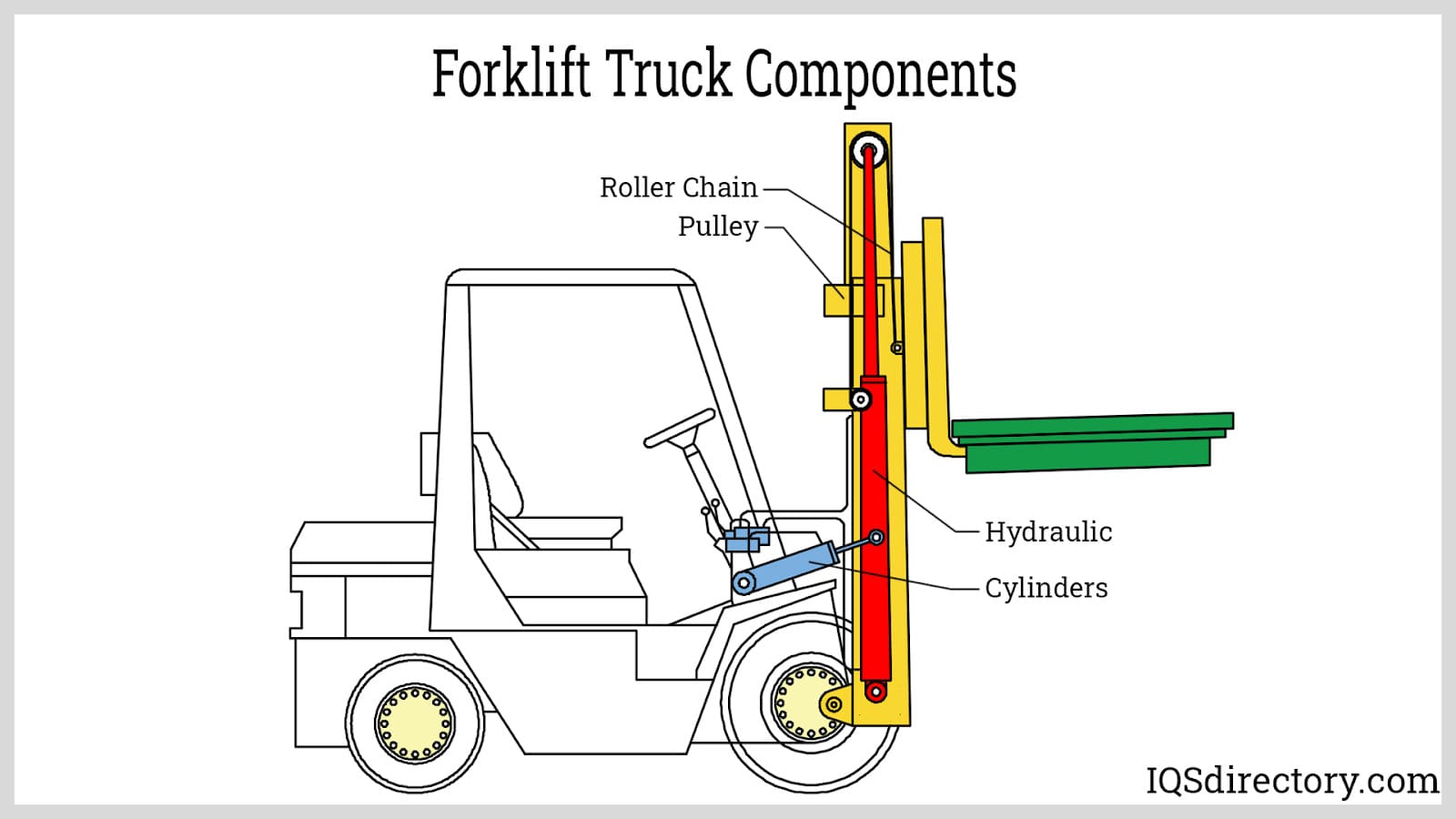 Forklift truck, an electrical or gas powered industrial equipment with a metal fork platform attached to its front to lift heavy loads.
Forklift truck, an electrical or gas powered industrial equipment with a metal fork platform attached to its front to lift heavy loads.
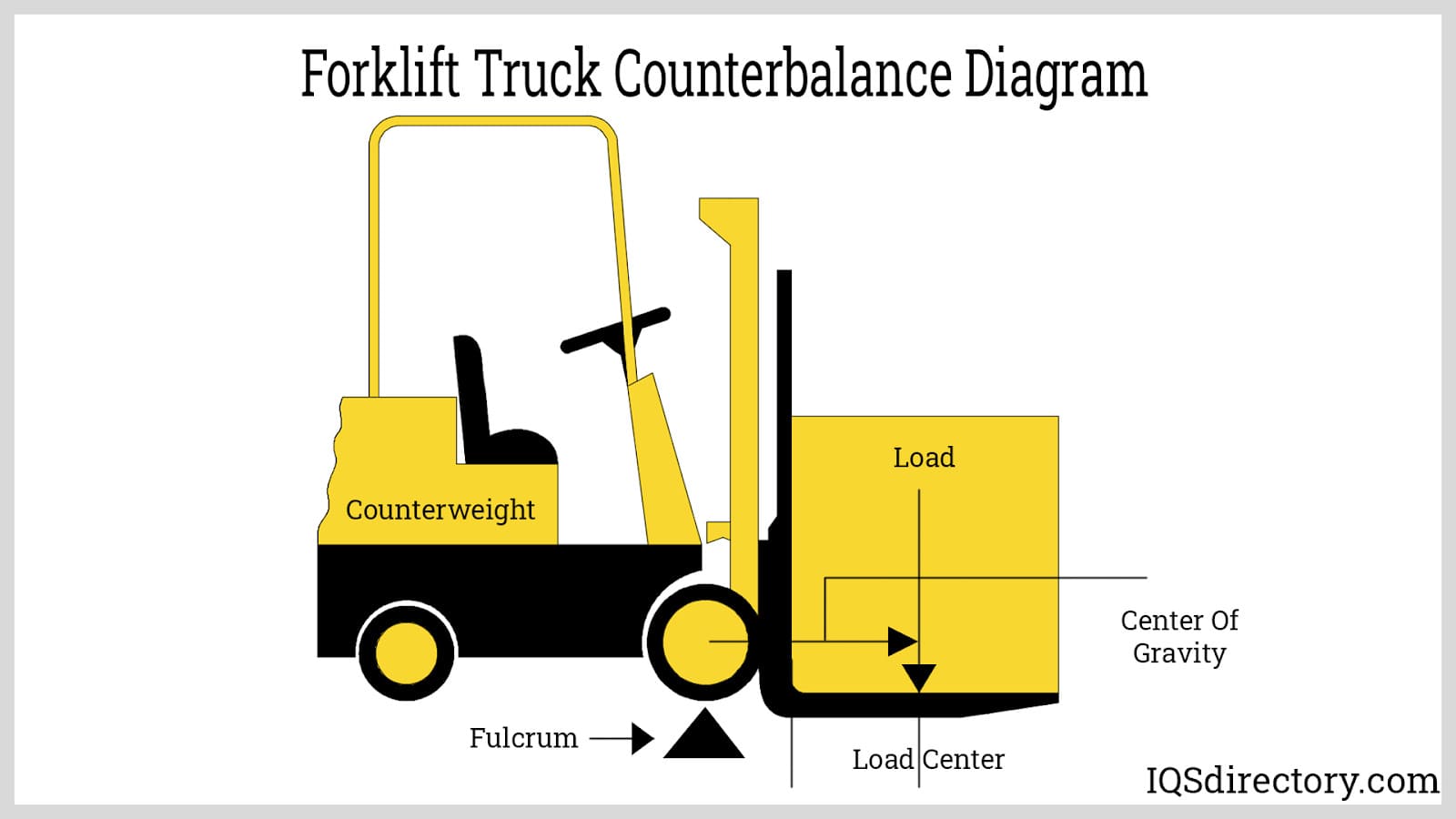 Counterweight is attached to the rear of the forklift to counterbalance the lifted load.
Counterweight is attached to the rear of the forklift to counterbalance the lifted load.
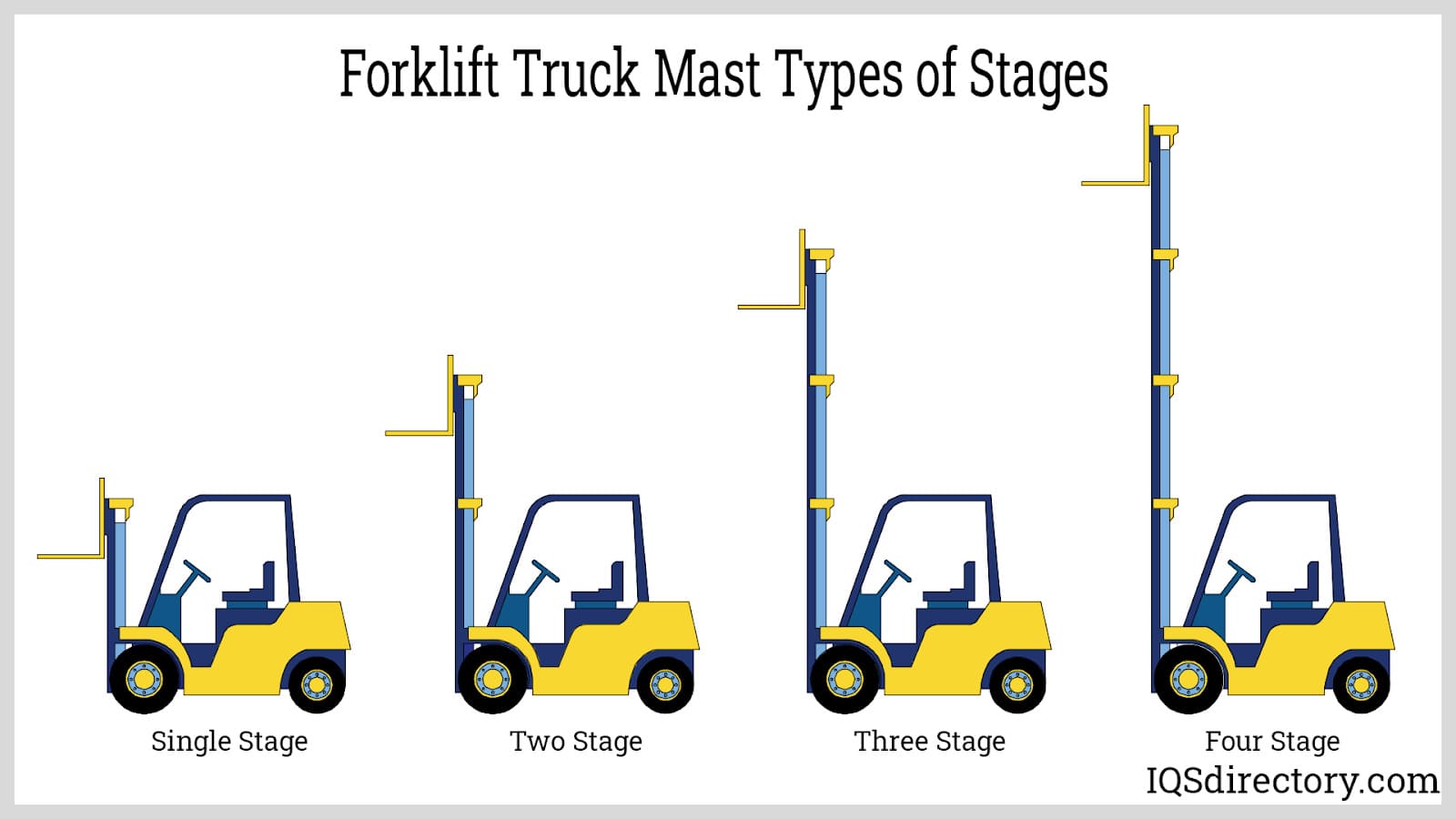 The mast of a forklift truck, is the vertical assembly that raises and lowers loads and includes interlocking rails for lateral stability with rollers or bushings as guides.
The mast of a forklift truck, is the vertical assembly that raises and lowers loads and includes interlocking rails for lateral stability with rollers or bushings as guides.
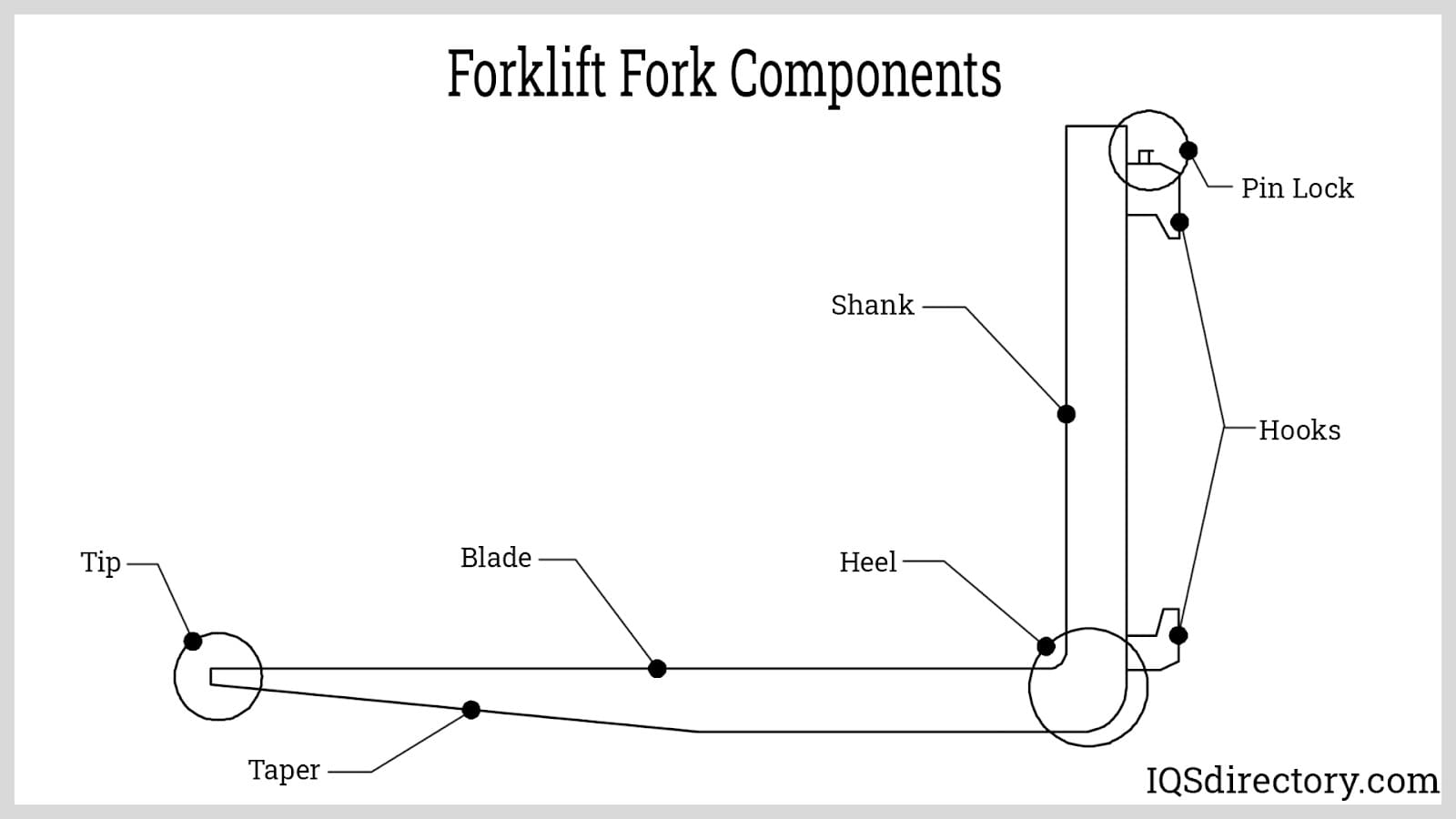 The forks make contact with the load, the dimensions and conditions of the forks guarantees the safe operation and prevents possible damage.
The forks make contact with the load, the dimensions and conditions of the forks guarantees the safe operation and prevents possible damage.
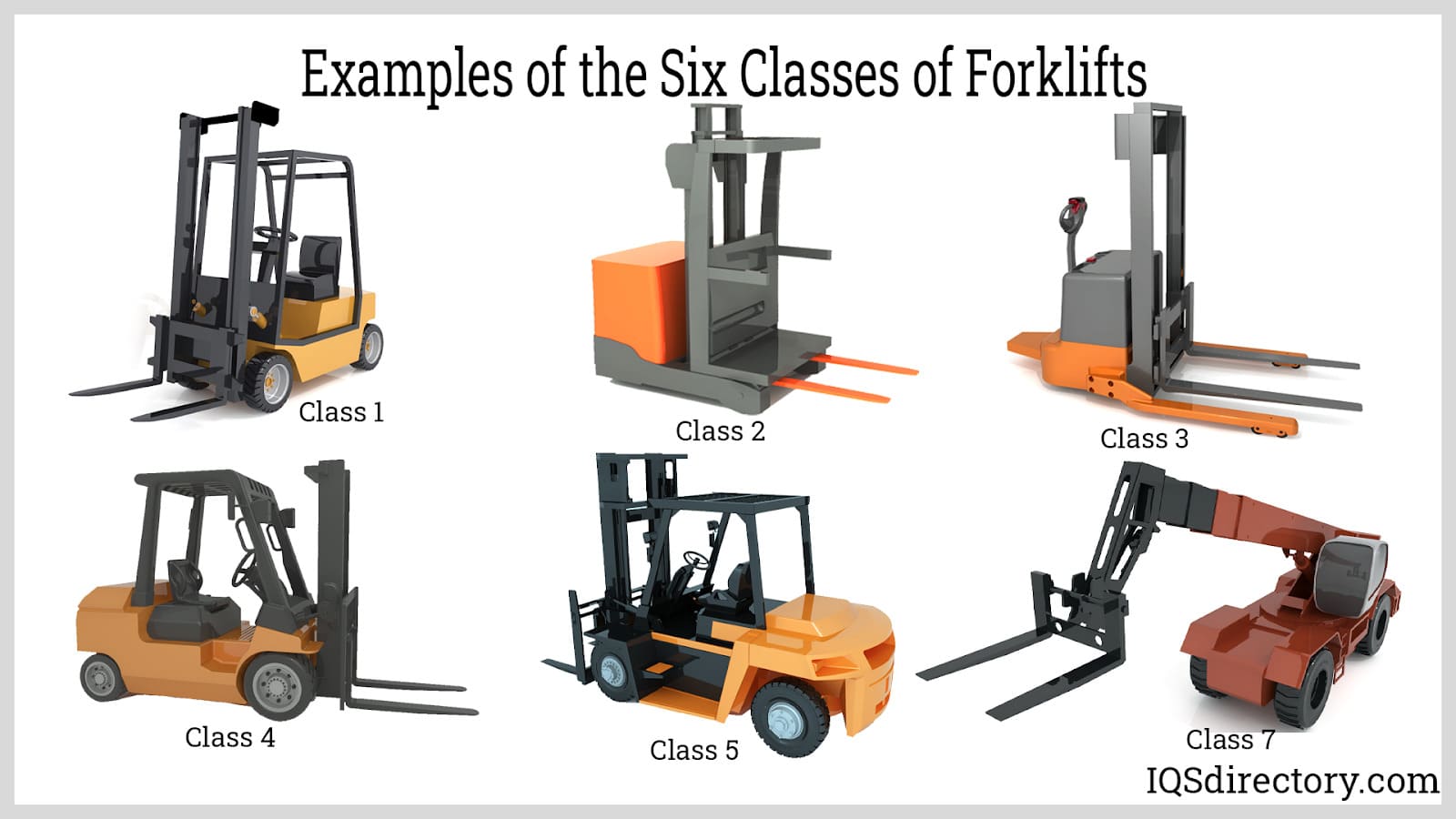 Forklift trucks are grouped according to their size, weight limit, operational terrain, and power supply, which each classification requires operators to be certified.
Forklift trucks are grouped according to their size, weight limit, operational terrain, and power supply, which each classification requires operators to be certified.
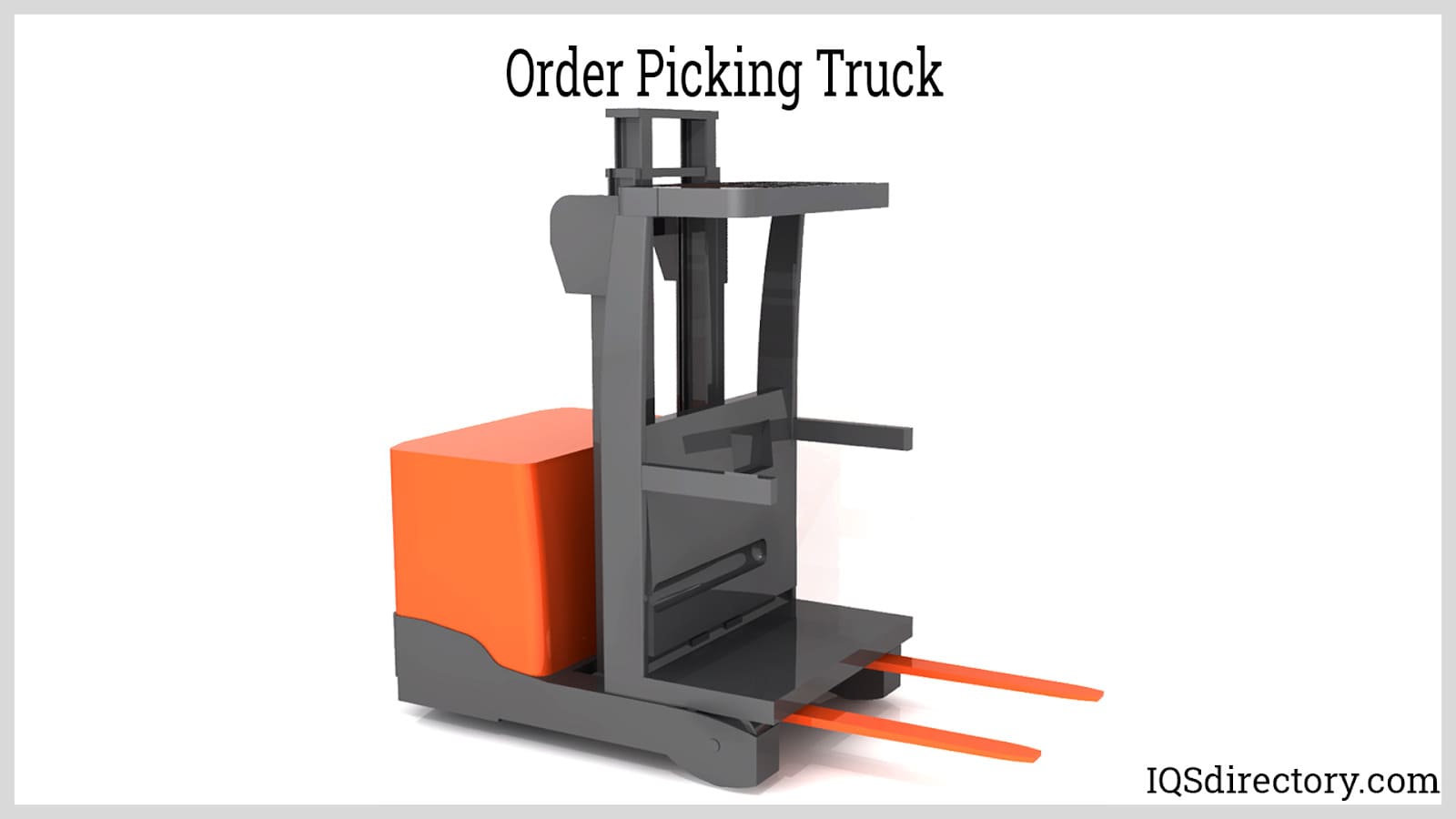 A stand up forklift truck where the operator frequently leaves to load and unload items.
A stand up forklift truck where the operator frequently leaves to load and unload items.
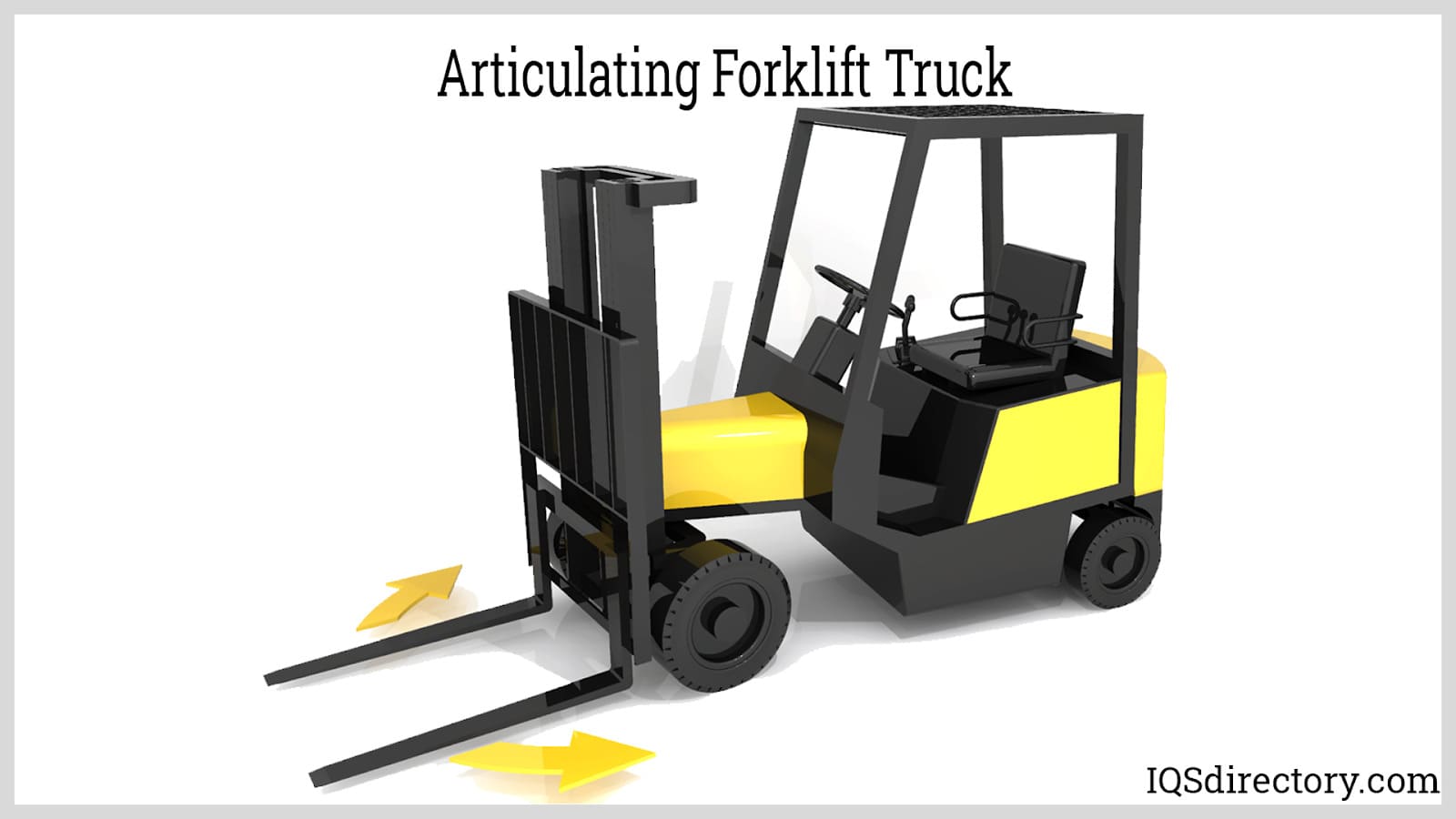 Forklift trucks are designed to safely and efficiently lift heavy loads.
Forklift trucks are designed to safely and efficiently lift heavy loads.
Types of Forklifts
Manufacturers categorize forklifts based on design and capacity, with key factors including the type of engine, tires, and counterbalance method. Counterbalancing, which uses strategically placed weights to prevent the forklift from tipping under heavy loads, is a more efficient solution compared to placing supports directly under the load.
Major Classes of Forklifts
Forklifts are classified into seven distinct classes:
Electric Motor Riders (Class 1)
These rider trucks, either stand-up or seated, are powered by an electric motor. They are typically counterbalanced with either cushion or pneumatic wheels.
Electric Motor Narrow Aisle (Class 2)
Electric motor vehicles designed for narrow aisles or stock picking functions. They may feature additional options such as extended reach or swing masts.
Electric Hand Riders (Class 3)
These vehicles, operated by a walk-behind or standing rider controller, are also powered by electric motors. Common applications include automated pallet lift trucks and high-lift models, often with an offset design.
Internal Combustion Forklifts with Cushion Tires (Class 4)
Equipped with internal combustion engines, these vehicles feature cabs with seated controls for the operator and are typically fitted with cushion tires.
Internal Combustion Forklifts with Pneumatic Tires (Class 5)
These forklifts, similar to Class 4, feature internal combustion engines and cabs with seated controls. However, they are equipped with pneumatic tires and are commonly counterbalanced for stability.
Electric and Internal Combustion Engine Tractors (Class 6)
These tractors are designed for towing applications, utilizing either electric or internal combustion engines.
Rough Terrain Forklifts (Class 7)
Built for challenging outdoor environments such as construction sites, these forklifts are equipped with large tires and extended reach capabilities to handle rough and uneven terrain.
Each forklift class is designed to meet specific operational needs, making them better suited for particular applications. For instance, rough terrain forklifts excel in construction sites where large tires and enhanced reach are essential.
Parts of a Forklift
Forklifts come in various types designed for different applications, but most share a common set of essential components. These include the frame, power source, mast, carriage (with forks and load backrest), counterweight, and the operator's station.
Frame
The frame serves as the base of the forklift, providing structural support and housing critical systems like cooling. Frames often allow for tilting and rotating, improving maneuverability. In addition to its structural role, the frame helps dissipate heat generated by the forklift’s hydraulic system.
Power Source
Forklifts are powered by either internal combustion engines or https://www.iqsdirectory.com/electric-motors/. Common fuels include gasoline, compressed natural gas, diesel, liquid propane, and batteries. Internal combustion engines are typically housed underneath the operator’s seat, except for propane engines, which are usually mounted externally. A newer development in forklift technology involves hybrid power systems, combining diesel with lithium-ion batteries.
Cab Enclosure
Most forklifts feature an enclosed operator’s cab, where the driver controls the vehicle using a steering wheel and other controls. In these vehicles, the steering wheel typically controls the rear wheels for improved precision, and some models may have knobs to facilitate quicker turns. Most cabs have an overhead guard to protect the operator from falling objects. There are also stand-up forklifts where the operator remains standing while driving.
Mast
The mast is the vertical component that allows the lifting and lowering of the forklift’s carriage and forks. It operates hydraulically and consists of connected rails with channels called "stages." Forklifts commonly use three-stage masts, with each additional stage providing greater lifting power. Masts are critical for reaching high shelves, which is a common task in warehouse operations.
Carriage
The carriage connects the mast to the forklift’s lifting attachments, such as forks. It is typically mounted at the front of the forklift, but side-loaders use a different setup where the lifting mechanism is positioned on the side. The carriage can be moved horizontally or tilted using controls in the cab, allowing it to handle different types of loads efficiently. For heavy-duty applications, reinforced stabilizing bars may be used to ensure stability during lifting.
Forks (Tynes)
Forks are one of the most recognizable parts of a forklift. These elongated attachments are designed to carry loads by inserting them underneath. Forks vary depending on their intended use. For example, pallet truck forks are tailored to fit standard pallet designs, while double-extended forks are used for deep-reach applications. Forks can be adjusted in angle using the tilt cylinder to accommodate different load types. Safety rails may also be installed to prevent loads from slipping off.
Load Back Rest
The load back rest is the rear portion of the lifting platform, mounted to the carriage, which helps stabilize the load during transport.
Counterweight
Counterweights balance the forklift by offsetting the weight of the load. Typically located at the rear of the forklift, they ensure stability. In electric forklifts, the battery often functions as the counterweight.
Wheels
Forklift wheels come in two main types: pneumatic tires and cushion tires. Pneumatic tires resemble regular automobile tires and are filled with air, providing load vibration padding and increased traction. These tires are suited for outdoor environments. Cushion tires are solid rubber and require no inflation, making them more durable and easier to maintain. They are generally used for indoor environments with hard, flat surfaces but can also be used outdoors in smooth conditions. Stabilizing outriggers can be added to both types of wheels for extra support.
Safety Features
Safety features such as flashing lights or audible sirens help alert nearby workers to the forklift's movements, reducing the risk of accidents. Other safety features may be less visible, such as the relief valve, which detects excessive cylinder pressure and prevents damage by releasing pressure and draining oil back into the reservoir.
These components work together to ensure forklifts are effective, reliable, and safe for various applications.
Where Forklifts are Used
Forklifts and pallet trucks are essential across many industries that handle heavy goods or large quantities of materials. Their use improves storage efficiency, reduces injury risks, and shortens stocking times. These machines are invaluable in various environments, including indoor and outdoor settings, where they can be tailored to meet specific operational needs. Forklifts are especially useful in storerooms, construction sites, and loading docks, where mechanical power significantly enhances efficiency. They also help maximize vertical storage space by allowing loads to be stacked as high as the forklift can reach.
Other Types of Forklifts
In addition to the standard forklifts, there are numerous other types, each designed for specific tasks and applications:
Side-loaders
Used for heavy-duty applications, these forklifts are designed to handle loads from the side, making them ideal for long or bulky items.
Reach trucks / Order Picker Trucks
These warehouse forklifts are designed to reach high shelves, making them perfect for accessing products or equipment stored at great heights.
Pallet Trucks
A specialized lift truck designed specifically for lifting and transporting loaded pallets, these trucks are common in warehouses and distribution centers.
Indoor Walkie Forklifts
Electric forklifts designed for indoor use on smooth concrete floors. These compact forklifts are ideal for tight spaces.
Straddle Trucks
These forklifts feature a wider base and can lift heavier loads higher than typical forklifts, making them useful for specific high-capacity tasks.
Turret Forklift Trucks
These forklifts are capable of rotating a high load up to a 90-degree angle, providing greater maneuverability in narrow aisles.
Platform Trucks
A flatbed material-handling vehicle with either a manual handle for operator movement or a motorized system with a seat. While not strictly lift trucks, platform trucks are used in similar material transportation applications.
Automated Forklifts
A recent innovation, these forklifts function autonomously using sophisticated guidance systems. They are becoming increasingly popular in industries like aerospace, automotive, and manufacturing.
Manual Drive Forklifts
Operated manually by an individual walking behind the forklift to move loads. These are ideal for smaller, lighter loads or when space is tight.
Motorized Drive Forklifts
These forklifts feature a cab or seat for the driver to operate while riding. They are particularly useful for covering larger distances across warehouses or manufacturing floors.
Forklifts are highly customizable with a wide range of accessories to suit various functions. For example, they can be equipped with attachments for moving barrels instead of pallets, offering even more versatility for different industries.
How to Use a Forklift
Forklifts are incredibly valuable in various commercial settings, but they come with significant safety risks. Improper use can lead to accidents, collisions, or even tipping over, potentially causing serious injury or equipment damage. Therefore, maintaining forklift safety in environments such as manufacturing or construction is crucial. The following overview highlights essential forklift safety practices, though operators must undergo thorough training and certification before being allowed to operate forklifts in the workplace.
Forklift Safety
The foundation of forklift safety starts with preparation. Before turning on the engine, operators should inspect key components like fluid levels, hydraulic tubing (hoses and connectors), tires, and forks for any wear or damage. Once the engine is started, operators should test other critical systems, including controls (e.g., tilt lever, lift lever), warning lights, and alarms. When entering the forklift, always use the appropriate handholds and carefully slide or pull yourself into the vehicle—avoid jumping or stepping into it. Never operate a forklift from any position not approved by the manufacturer’s operating manual.
A common mistake among new forklift operators is assuming that operating a forklift is similar to driving a car. While there are similarities, significant differences exist. For example, forklifts are powered by rear wheels, which changes how they handle. To drive safely, operators should utilize features like rearview mirrors, concave mirrors, and headlights. Additionally, businesses can enhance forklift safety by using spotters, physical barriers, and color-coded zones to separate pedestrian and forklift traffic.
Visibility and Caution in Forklift Operation
Visibility and caution are key when operating a forklift. Maneuvering can be challenging, especially when changing direction or momentum. Best practices include:
- Making slow, sweeping turns.
- Cutting inside when turning to offset the rear of the forklift swinging in the opposite direction.
- Looking behind when reversing.
- Braking smoothly instead of abruptly.
- Never turning with raised forks.
- Avoid turning on inclines or grades, no matter how slight.
Forklift Load Capacity
A fundamental safety rule is never to exceed the forklift's maximum load capacity. This capacity assumes the load is centered, so it's essential to ensure the load is properly aligned and secured before and during transport. When handling loads, follow these guidelines:
- Approach the load cautiously, stopping at least a foot in front of it before moving slowly into position.
- Ensure the forklift is fully stopped before moving the forks.
- Position the forks as level and as wide as possible, inserting them under the load as far as possible (at least two-thirds of the way).
- Never remove the load backrest, as it provides critical stabilization. If the load becomes unstable, tilt the carriage back to use the backrest.
- Always carry loads at a low height.
- Avoid tilting the carriage forward with a load.
- If a load blocks your view, travel in reverse to maintain visibility.
- Check for sufficient overhead clearance before lifting loads.
Pedestrian Safety
Minimizing pedestrian collisions is a vital part of forklift safety, especially in busy environments. To prevent accidents, consider the following:
- Use spotters and color-coded zones to warn pedestrians of forklift traffic and prevent collisions.
- Remember that not all individuals in the forklift area may be familiar with forklift operations.
- Be mindful of noise levels in the environment, as excessive noise can obscure forklift alarms, even for experienced operators.
Things to Consider When Purchasing a Forklift
Forklifts are essential equipment in manufacturing environments, but their high cost, particularly when purchased new, combined with their variability, can create challenges for companies operating multiple production facilities with different needs. As a result, businesses may need multiple forklifts tailored for various purposes, which adds complexity to the decision-making process.
Communication With the Manufacturer
Effective communication with your forklift manufacturer or supplier is crucial to ensuring you get the most out of your forklifts. It’s essential for customers to be clear and specific about their forklift requirements, and equally important for suppliers to have the expertise and patience to help identify the best forklifts for your specific needs. The performance of a forklift is influenced by several factors, all of which play a role in determining the forklift’s value for a particular application.
Some key factors to discuss when exploring forklift options include:
Vertical lift travel: The height the forklift or reach truck can lift.
Lift capacity: The maximum weight the forklift can handle.
Type of mast: The mast directly impacts vertical lift capacity.
Nature of the material: What type of material the forklift will handle.
Forks required: Whether you need standard ITA forks or custom ones.
Operating environment: The conditions, such as indoor vs outdoor environments and surface types.
Usage frequency: The estimated number of hours the forklift will be used per day or week.
Forklift Options
Choosing the right forklift for the job is crucial. For example:
Compact warehouses: Narrow aisle forklifts are ideal for maneuvering in tight spaces.
Quick refueling needs: Forklifts powered by fossil fuels, particularly propane, are best suited for scenarios requiring rapid refueling.
Electric forklifts: These are preferred for various applications, particularly when air quality preservation is a priority. With stricter emission regulations and the longer lifespan of electric forklifts, they are often chosen over gas or fuel-powered options.
Customization for Forklifts
Forklifts can often be customized for specific tasks beyond basic material handling. Attachments such as sweeping, plowing, or even boom crane features can increase a forklift's versatility, making it more valuable for diverse operations.
Proper Maintenance Schedule
To ensure the longevity and effectiveness of forklifts, a proper maintenance schedule is essential. Regular maintenance helps extend the lifespan of the vehicle and can save money in the long term. Some forklift suppliers offer used forklifts for sale and provide routine service options that keep the vehicles in optimal working condition.
Forklift Terms
-
ANSI B56.1
The American National Standards Institute (ANSI) standard for safety in low-lift and high-lift trucks, approved by the American Society of Mechanical Engineers (ASME).
Axle Weight
The distribution of the load across the wheel axles, either when the vehicle is unloaded or weighed down.
Baseleg Opening
The measurement between the inside of the baselegs, specifically at their narrowest point.
Batching
A method of compiling several orders for optimal picking rate, which are then sorted at a centralized location.
Bi-Directional
A vehicle that is designed for both forward and reverse travel.
Carriage
The structure that supports the forks or other attachments on a forklift, typically roller-mounted, and moves vertically within the mast.
Carts
Containers used to hold or transport items selected for fulfilling an order, often customized to meet specific requirements.
Carton Clamp
A hydraulic blade attachment fitted to forklift trucks that allows for the handling of cartons without the need for pallets.
Deck
One or more boards that make up the top or bottom exterior of a pallet.
Drivers Cabin
A protective enclosure for the forklift operator, shielding them from outdoor weather conditions, coolers, freezers, or falling elements indoors.
Dwell Time
The total stop time spent at the pick front during the order picking process.
Forks
Horizontal projections that are suspended from the carriage to support loads.
Load Center Horizontal
The horizontal distance from the fork face and fork heel intersection to the load's center of gravity.
Load Center Vertical
The vertical distance from the carrying surface of the fork to the center of gravity of the load.
Load Wheel
In reach and straddle trucks, the wheels located in the baselegs.
Lowering Speed
The velocity, in feet per minute (FPM), at which the load carriage is lowered during operation, in both loaded and unloaded conditions.
Module
The device or container where items are deposited during the picking process.
Outside Turning Radius
Half the diameter of the circle made by the outermost projection of the truck during turning.
Pallet
A load-carrying structure with stringers and decks designed for easy pickup by a forklift.
Pick
The process of locating, counting, and retrieving an item for transportation to another area or for customer retrieval.
Rail
Part of a side guidance system used with forklifts, which also absorbs vehicle weight.
Reverse Steer
A steering option where the vehicle turns to the right when the steering wheel is turned counterclockwise, with the operator facing away from the direction of the forks.
Sideshift
A commonly used forklift attachment that allows the fork carriage to move left and right for more precise placement of cargo.
Skid
A type of pallet that lacks a bottom deck.
Stringer
A continuous longitudinal beam, either solid or notched, used to support the deck components of a pallet. It is typically recognized as the outer or center stringer depending on its location.
Underwriters Laboratory Listing (UL)
A list of forklift models recognized by insurance companies to help determine coverage rates. Underwriters Laboratories is an independent testing agency.
Wheel Loading
The measure of the effect that axle loading has on the floor surface where the forklift operates. It includes:
Force: The concentrated reaction force per tire, in pounds, exerted by the wheel on the floor.
P.S.I.: The wheel loading in pounds, divided by the wheel contact area in square inches.

